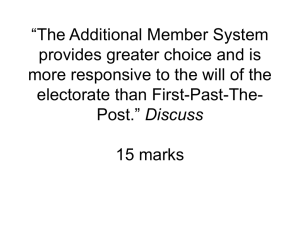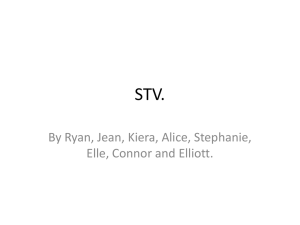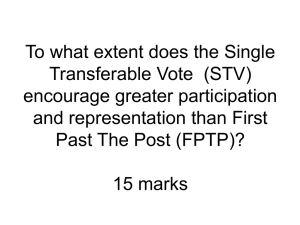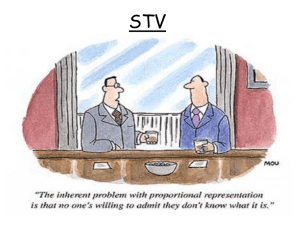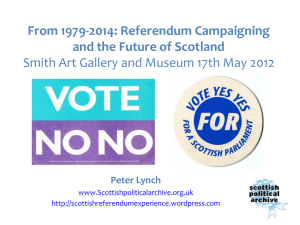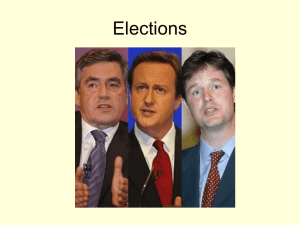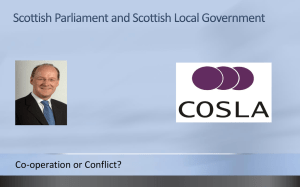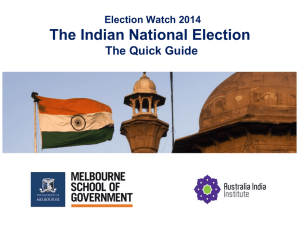Voting Systems - Schools Project
advertisement
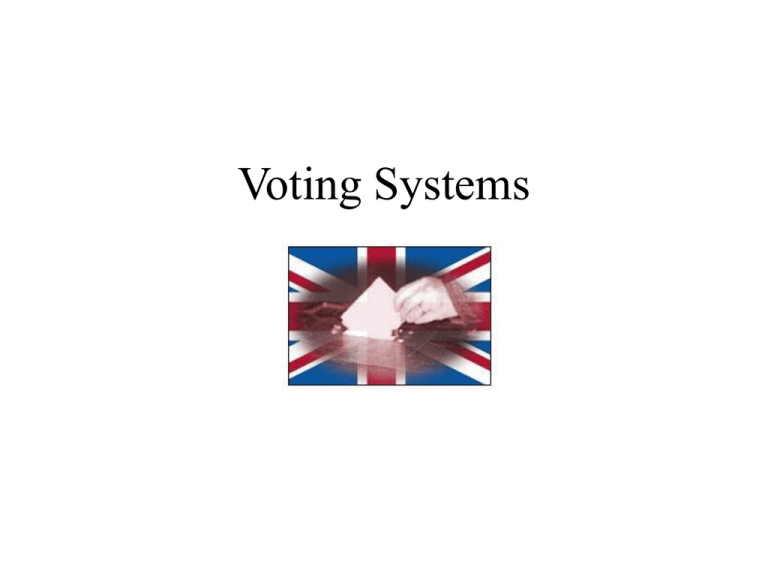
Voting Systems Before setting out on a journey it’s a good idea to have some idea of where youre heading … • 2010 – The Single Transferable Vote electoral system provides for better representation than First Past the Post. Discuss. • 2009 – Critically examine the view that the media is the most important influence on voting behaviour • 2008 – Assess the influence of social class on voting behaviour. • 2007 – “The Additional Member System gives voters more choice and better representation than does First Past The Post.” Discuss. These questions suggest this topic may not be too bad in the exam … … but of course this will only be the case if you have done the revision which allows you to answer a question on Voting Systems or Voting Behaviour. So – you have 22.5 minutes and a lot of information in your head. You can’t write it all down so read the question again. What are they asking? A lot of candidates answer the question they want to answer, not the question on the paper. They normally end up writing too much including lots of irrelevant info which the marker cannot give marks for. So read the question carefully and then go for quality rather than quantity. The best approach is probably to start with a short plan – simply a few bullet points or words & dashes. This is when you may organise your answer into: ‘para 1’ ‘para 2’ ‘para 3’ To these you add an Intro and Conclusion. When you start the answer, the plan helps you get through things more quickly and in better order. Topic Summary In UK parliamentary elections the 3 main parties – C_________, L_____ and Lib Dems – win the vast majority of votes and s____s. However, the share of votes does not match the share of seats because of the way the FPTP voting system works. Generally, L_____r or C________s gain power at Westminster but the 2010 general election was very un______ and it resulted in a Conservative & Lib Dem c________ g_________. In elections for the Scottish Parliament, the voting system (AMS) is a form of proportional rep____________ and this means the share of seats does roughly match the share of v____s gained. Labour and SNP are the m___r parties with the Conservatives and Lib Dems winning fewer seats. The AMS voting system makes it difficult for any party to gain outright c______, so coalition or m___rity governments are more likely. The two elections 1999 & 2003 resulted in Labour–Lib Dem coalitions but after the 2007 election the SNP formed a minority government which remains in p____r. The next Scottish Parliament election will be held in ______. There are two other voting systems we need to know about. The Single Transferable _____ (STV) is used for local g_________t elections in Scotland while the Party List System is used for the election of Members of the Eu_______n Parliament (MEPs). Finally, the c___tion government plans to hold a r______dum on the Alternative Vote (AV) system to replace FPTP .. Lib Dems will support it but Conservatives will campaign against! The system we use at Westminster for electing the UK government is of course First Past The Post. You probably know how this works already. It’s simple. The UK is divided into 650 constituencies. Each elects one Member of Parliament. Voters mark an X on their Ballot Paper. The Candidate with the most votes wins and takes their seat in Parliament. The party with the most seats forms the government. You are unlikely to get a question asking you just about FPTP. However, you may be asked to compare a PR system such as AMS with FPTP. So it is useful to know the main advantages and disadvantages of FPTP. FPTP Keyword: CELTS V GERS Advantages of FPTP CELTS Cheap – to change to a system of PR could be expensive Easy for voters to understand Link between voters and their elected representative is clear The result is usually decisive producing a govt with outright majority (not in 2010) Strong stable governments likely Advantages of FPTP CELTS Cheap – to change to a system of PR could be expensive and complicated Easy for voters to understand - FPTP produces very few wasted voting papers whereas in the 2007 Scottish P__________ election under AMS an incredible 7% were wasted – this may have been partly due to the more complex ballot paper with 2 votes (but the main reason was probably the decision to hold council elections at the same time with different types of ballot papers) Link between voters and their elected representative is clear (e.g. MPs s_________s are very important to voters in the UK) The result is usually decisive producing a govt with an outr____ majority (more MPs than all other parties combined) – this did not happen in 2010 but it did in 7 elections before. In 2005 Labour gained 66 seat overall majority with only 35% of the votes. An outright or overall majority means the manifesto of the winning party may be delivered without too many changes. The winning party can also claim it has a mandate (i.e. voters permission) to enact its policies. Strong stable governments are likely with one party in overall control and usually a clear Opposition party which suits our adversarial style of Parliament (political stability usually means economic stability which is very important to business in the UK and to the global companies which may wish to invest in the UK) Disadvantages of FPTP GERSS Govt elected does not truly represent wishes of electorate Extreme government is possible because of overall majority Regions can become power bases – skewed policies Smaller parties with evenly spread votes are treated unfairly Safe seats may be ignored while parties focus on marginal seats Disadvantages of FPTP GERSS Govt elected does not truly represent wishes of electorate and is normally elected by a minority (e.g. Labour govt elected in 2005 gained an overall majority of 66 seats – i.e. 55% of the seats on only 35% of the votes). Extreme government is possible because an overall majority means the government can ignore the opposition e.g. many Scots accused the Thatcher govt in the 80s of extreme p_____ies which the majority of Scots opposed and which they claimed harmed Scotland. On the other hand, Mrs T was elected by the UK as a whole and Scotland is ____ of the UK so in this sense the system was fair. Regions can become power bases (e.g. Labour and west of Scotland ) so FPTP may tempt parties to try to keep support in a region with skewed or unbalanced policies to keep voters happy. Smaller parties with evenly spread votes are treated unfairly because they can gain a lot of support around the country but win very few seats because they do not come first in constituencies unlike the big two parties. This happens because under FPTP parties benefit if their votes are ‘lumpy’ rather than ‘evenly spread’ – in other words, concentrated in some areas rather than s_____d evenly around constituencies (e.g. Lib Dems often come 2nd - but gain nothing when they do so). The Greens also have a lot of support spread around the UK but have only ever had one MP elected to the House of Commons under FPTP.) Safe seats are common (though were less so than before) and may be largely ignored during elections as parties focus all their energies and resources on marginal seats which are more likely to change hands – (e.g. in the 2010 election, a businessman Lord Aschcroft gave the Tories millions to spend on targeted marginal seats and this may have had a big impact on the final result. The alternative to FPTP is a form of Proportional Representation which tries to allocate seats more accurately based on the share of the votes parties receive. There are different types of PR system but before we look at two of these we can look at some general advantages & disadvantages of PR. Keyword: MAD V LUPI Advantages of PR: MAD Moderate Government is more likely Access for smaller parties is improved Democracy gains as Parliament reflects spread of votes Advantages of PR: MAD Moderate Government is more likely as a hung p_________t is common with PR … which in turn leads to c________n govts … resulting in more moderate policies as parties amend their manifesto in deal-making. (e.g. first ____ elections to Scottish Parliament produced coalitions and the current SNP government is a minority govt which means its policies must be toned down to gain support from other parties). Access for smaller parties to Parliament is improved because they can gain MPs without having to come f___t in constituencies (S_______ P_________ has seen a number of smaller parties win seats especially in 2003 election when 7 Greens and 6 Scottish Socialist MSPs were elected) Democracy gains because the true wishes of the voters are reflected in the make up of the Parliament more accurately than they are under FPTP (e.g. in 2007 Scottish Parliament election SNP gained around 32% of the vote and 37% of the seats while Labour gained around 31% of the votes and 36% of the MSPs. This is not wholly fair – but is much f_____r than FPTP. Disadvantages of PR: LUPI Link between voter and representative may be weakened Unstable weak governments are more likely Parties which are small may gain too much influence Inconsistent policies - they change when parties bargain. Disadvantages of PR LUPI Link between voter and representative may be weakened (e.g. in the Scottish Parliament the direct link with constituency MSPs is clear but link with regional MSPs it is much less clear.) Unstable weak governments are more likely because PR tends to produce a hung parliament which is likely to lead either to a minority govt (e.g. present SNP govt has only one more seat (47) than Labour (46)) or to a coalition govt (e.g. 1999 & 2003 saw Labour - Lib Dem coalitions). On the other hand, the coalitions proved to be stable in the Scottish Parliament and the SNP minority government has also surved better than many expected. Parties which are small may gain too much influence if a larger party wants to form a coalition with them e.g. in 2003 the Lib Dems formed a coalition with Labour in the Scottish Parliament which gave them some ministerial posts and a big say in govt – yet they were only the 4th largest party with 17 seats and only 14% of the votes cast. Inconsistent policies - they change when parties bargain with each other to form a coalition or to get legislation through when there is a minority govt. e.g. the price Labour paid to form a coalition with the Scottish Lib Dems in 2003 was to agree PR (in the form of STV) would be used in local government elections. This system was first used in 2007. Many people who are Labour voters intensely dislike PR and were been angered to see it introduced – especially as Labour then lost control of so many local councils in 2007. Now we look at some forms of PR The system we use for the Scottish Parliament is The Additional Member System (AMS) Here is an example of the AMS ballot paper for the Scottish Parliament election in 2007 … How AMS Works: The Additional Member System is a combination – a hybrid – of the First-Past-The-Post system and Party List voting. The purpose is to retain the best features of First-Past-The-Post while adding proportionality between parties through party list voting to ensure a fairer result. AMS was introduced for th Scottish Parliament in an effort to produce a different type of politicas than the adversarial politics of Westminster. For the Scottish Parliament each voter has two votes, one vote for a constituency MSP allocated via FPTP, and one for a regional party list. 73 of the MSPs are allocated to the single-member constituencies. The remaining 56 MSPs are allocated via the Regional List. For this, the country is divided into 8 large regions each of which elects 7 List MSPs. This means each voter has 1 constituency MSP and 7 regional list MSPs to represent him or her. The two groups (73 & 56) add up to a total of 129 MSPs. The Regional List MSPs are used to top up the FPTP seats gained by each party to produce a fairer, more balanced result based on the share of the votes parties received. If you want some extra detail on AMS for the Scottish Parliament, follow the link below: www.scottish.parliament.uk/vli/education/resources/learningResources/higherElections.htm The Scottish Parliament - Counting The Votes Firstly, the constituency votes are counted and candidates who receive the most votes are returned as the MSPs for the 73 c__________ies. 56 Regional list MSPs are then allocated to balance the result (using the d’Hondt formula) The number of regional list votes cast within a region for each party is divided by the number of constituency s______ they won in that region +1. The party with the h________ resulting figure gains the first regional seat. To allocate the second regional seat the calculation is redone with additional seats gained being added to the calculation each time. The seats which the formula determines each political party is entitled to are filled by candidates in the order in which their names appear on the party l___t submitted before the election. (An example of the workings is shown on the next slide.) How the 7 additional MSP seats are allocated within a region. This example is optional – you will not need this in the exam. In East Lothian … East Lothian is a constituency of the Scottish Parliament (Holyrood). It elects one MSP by the plurality FPTP method of election. It is also one of nine constituencies which make up the South of S______d electoral region which elects 7 additional members. In the 2007 Scottish Parliament election, the Labour candidate Iain Gray won more votes than his rivals and became the c__________y MSP. However, to give some compensation to the parties who may have secured a decent number of votes sp___d out across the wider South of Scotland region, seven Regional List seats - (each of Scotland’s regions has 7 additional list members) - were allocated according to the proportion of the vote each party received. The end result in East Lothian was that Ian Gray became the constituency MSP. Of the 7 additional list MSPs for the wider South of Scotland region, 5 went to the SNP. One of these is Mike Russell (SNP) who is the Secretary for E_______n & Lifelong Learning in the Scottish Government. Therefore, if a con____ent in East Lothian has an issue in the area (e.g. crime) he/she could go to Ian Gray (Labour) to do something, but could, in theory, approach a ’list’ MSP instead, such as Christine Grahame (SNP), Derek Brownlee (Conservative) or Jim Hume (Lib Dem). Arguments in favour of AMS: • It results in broadly proportional representation but still ensures there is a directly accountable MP for each constituency. • It retains a number of single-member constituencies. • It has produced stable governments in Germany & Scotland (Scotland1999-2007) • Each elector has two ways of expressing their democratic preference • AMS means all voters have an impact, if not through the constituency MSP then at least through the regional list MSPs. There are more detailed arguments in favour of AMS on the the sheet: Additional Member System (AMS) Advantages of AMS If you cannot find this, it can be downloaded from the link below: www.schoolsproject.co.uk/msc/materials/ms/H/materials.htm Arguments against AMS: • It combines many of the faults of First-Past-The-Post with some defects of the list systems of PR. • The regional MSPs are not directly accountable to any voters, just to their party leadership, and have no individual constituency. • It creates two types of MP, one with a constituency role and duties and one without such a base – confusing for constituents (voters). • The parties retain complete power over choosing their list of Additional Members. Electors vote not for the individual list MSPs but for a party. Now make up more detailed notes on the disadvantages of AMS from the book ‘Modern UK Politics’ (Pages 102-104) Remember to include some statistics which you may be able to use in an essay or in the exam. Now we look at another type of PR system used in Scotland. Local councils are elected by Single Transferable Vote (STV). With the introduction of STV for the 2007 elections, council wards (the areas which elect representatives) were combined to make larger wards with more than one councillor elected for each ward. Voters now choose who they wish to vote for by ranking the candidates in order: 1 for their top choice, 2 for second, 3 for third and so on. They can stop after one name or they can go on to choose others if they wish. Follow the link below to find out How STV Works in practice: http://www.votescotland.com/stv/How_STV_Works.pdf Advantages of STV ... All votes count (just as in AMS) because of the process of reallocating votes when a candidate reaches the 'quota'. Smaller parties have a better chance of being elected (again like AMS) because system does not depend upon concentrations of votes in 'safe' areas. - explains why Labour lost out when STV was used for local council elections in 2007 Voters choose WITHIN parties as well as between them. e.g. SNP may put up 3 candidates in a 3 member ward. The voter may like one but not the other two so can choose her preferred SNP candidate as '1' on the ballot paper, but put '2' against a candidate from another party. STV empowers voters not parties. Under AMS, parties don't put names on Regional List ballot paper so parties rather than voters choose the individuals. With STV, all candidates are listed - so voters can choose individuals they want. Disadvantages of STV ... Multi-member wards /constituencies may confuse voters as the direct link to their single elected representative is no longer so clear. Voters have more than one person to represent them so who should they go to … and whose fault is it when things go wrong? Small parties could end up in a position of power despite receiving a small percentage of votes, if a large party needs their support to form a coalition. (The same can happen under AMS.) e.g. after STV was introduced for Scottish council elections in 2007 most of the 32 councils switched from one-party control to ruling coalitions. This meant a lot of negotiating between parties to reach deals and in some areas small parties found themselves in strong postions. Some predicted these coalitions would be unstable but in fact most have proved to be fairly stable and workable e.g. .. Elections to East Lothian Council were held in 2007: the first using seven new wards each electing three or four councillors by STV. The new wards replaced 23 single-member wards which were elected by FPTP. East Lothian Council has had a coalition SNP/Scottish Liberal Democrat administration since 2007. The current make up of the Council is: 9 Scottish National Party 7 Scottish Labour 4 Scottish Liberal Democrat 2 Scottish Conservative 1 Independent A breakdown of the councillors, their wards and the way in which they were elected by STV is provided at the web page below: http://en.wikipedia.org/wiki/East_Lothian_Council_election,_2007
